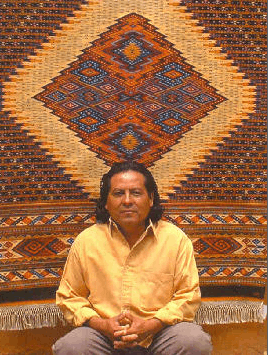Arnulfo Mendoza
Arnulfo Mendoza Ruiz (August 17, 1954 – March 7, 2014)[1] was an artist and weaver, who exhibited his work both in Mexico and abroad. Born in Teotitlán del Valle, Oaxaca, a well-known center for traditional Zapotec weaving, he became one of its best-known artisans, recognized as a “grand master” by the Fundación Cultural Bancomer. As director of La Mano Mágica gallery and with his former wife Mary Jane Gangier, he also worked to promote Oaxacan handcrafts.
Life
Mendoza was born in Teotitlán del Valle, Oaxaca, a Zapotec community near the state capital that is well known for its weaving of rugs. It has been successful enough in this endeavor that unlike many other communities in the region, few people emigrate from here.[2][3]
As age nine, he began his training in form, color and materials at his family’s workshop, learning traditional Zapotec weaving.[1][4] He went on to study at the school of fine arts at the Universidad Autónoma Benito Juárez de Oaxaca (UABJO) from 1972 to 1974.[1][5]
Mendoza later married Canadian Mary Jane Gangier, who had come to Teotitlán as a backpacker and fell in love with the area, as well as with him. They worked together to promote his work and that of other artisans in the central valleys of Oaxaca, by opening a gallery and writing. The couple divorced but Mary Jane stayed in Teotitlan to continue this work. The couple has one son, Gabriel Mendoza Gagnier.[1][3]
In 2014, Mendoza died unexpectedly of a heart attack at age 59. There was a wake in the city of Oaxaca as well as in his hometown, where he was buried.[2][4]
Career
Mendoza was one of Teotitlán’s most famous weavers, whose works sold for up to thousands of dollars.[3] He dyed his own silk and wool yarn and was particularly partial to the reds produced by the cochineal insect and sometimes used silver and gold thread.[3] He had over fifty individual and collective exhibitions of his work, including in museums in New York, Madrid, Dallas, Paris, Los Angeles and Berlin.[1][2] In 2003 his work was featured at the Weaving a Cultural Testimony exhibit at the Mexican Art Museum in Chicago .[5] His work can be found in the permanent collections of the Mexican Art Museum in Chicago, Tama Life 21 in Tokyo, Fundación Cultural Banamex, Waterloo Center for the Arts in Iowa and published in Cuento Mayas, Native Tradition (1982), Textiles de Oaxaca, Artes de México No.35 (1997) and Oaxaca Celebration (2005) .[5]
Just after graduating from UABJO, he became one of the founding members of the Taller (Workshop) Rufino Tamayo in 1974. In 1975 he supervised the production of tapestries of 25 artists in the United States to an exhibition at the Otis Art Institute in Los Angeles .[1][2]
In 1980 he traveled to Paris to paint for a year.[2] From 1987 to 2010 he founded and directed the Arnulfo Mendoza Workshop, producing tapestries with traditional and contemporary designs.[2]
In 1993 he participated in an International Art Project in Japan, with two of his works acquired by the largest public art collection in Tokyo.[1]
From 2009 to 2010 he was the director of the La Mano Mágica Gallery, one of the most recognized in Oaxaca.[1][2]
In 1996, the Fundación Cultural Banamex named him of one their “grand masters” of Mexican folk art (Grandes Maestros del Arte Popular Mexicano). In 2001 he was awarded the Chimalli de Oro by the El Imparcial newspaper.[1][2][5]
See also
| Wikimedia Commons has media related to Arnulfo Mendoza. |
References
- 1 2 3 4 5 6 7 8 9 Ernestina Gaitan Cruz (March 8, 2014). "Falleció el artista plástico oaxaqueño Arnulfo Mendoza Ruiz". Cronica de Oaxaca. Retrieved September 21, 2014.
- 1 2 3 4 5 6 7 8 Carina Perez Garcia (March 9, 2014). "Adiós a Arnulfo Mendoza: Falleció a los 60 años de los fundadores del TRT". Noticias Net. Retrieved September 21, 2014.
- 1 2 3 4 Mary Stucky (March 6, 2008). "Oaxaca's Weavers Keep Culture Thriving". Round the Earth Media. Retrieved September 21, 2014.
- 1 2 Janet Maza (March 9, 2014). "Último adiós al maestro Arnulfo Mendoza". Quadratín. Retrieved September 21, 2014.
- 1 2 3 4 "Arnulfo Mendoza Ruíz". Sistema de Información Cultural. CONACULTA. Retrieved September 21, 2014.